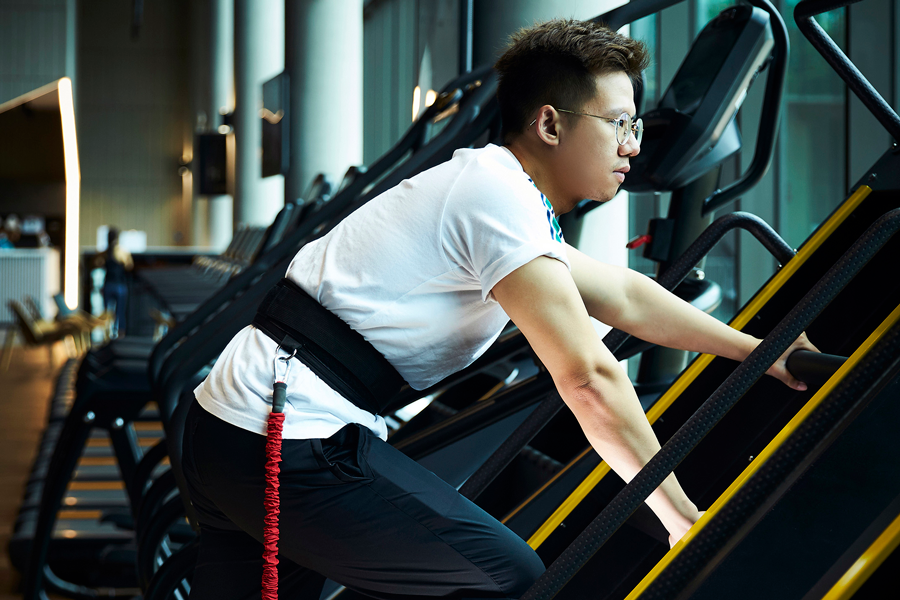TEXT: GILBERT WONG
PHOTOS: AIK CHEN

TEXT: GILBERT WONG
PHOTOS: AIK CHEN
Firefighters often face hazardous situations. Whether it’s a small residential fire or a large blaze at an oil refinery, our SCDF personnel are usually the ones putting their safety on the line as they plunge headfirst into danger. They’ll have to scale heights, evacuate casualties and place themselves in precarious circumstances — all in the course of a day’s work.
So how do firefighters prepare and train their bodies to handle the rigours of their job? We speak with Mr Jamal Moideen, fitness trainer and supervisor at HomeTeamNS Fitness Workz Gym to find out more about the essential and sometimes unconventional training that they have to go through.
Firefighters need great strength in their lower bodies to climb stairs efficiently while carrying heavy equipment, and thus exercises that help to develop muscular strength and endurance are vital. Various exercises lead to lower body gains, but weighted lunges are one of the best they can do to build strength in the core, legs, and glutes and tone up the body, says Mr Moideen.
In the line of duty, firefighters may also have to undertake rescue operations. Having a strong upper body is essential for situations where they have to break down doors or evacuate casualties.
For this, every firefighter will be all too familiar with one move for upper body development — the medicine ball slam. “Having a strong core is crucial and medicine ball slams engage all areas of the core,” says Mr Moideen. “This exercise creates rotational strength and can help firefighters become more agile while withstanding the physical demands of fire rescue situations.”
It’s not just strength that’s important when carrying out duties; firefighters have to ensure that they are able to go the distance and complete their mission no matter how long it takes. According to the SCDF, firefighters have to carry up to 60kg of equipment depending on the mission. Think of it as carrying another person — while performing dangerous tasks.
Training to have sufficient stamina to carry this extra load is therefore crucial. Cardiovascular exercises such as running, cycling, swimming and rope-jumping are some of the common methods of improving cardiovascular capacity, says Mr Moideen.
“Machines that can be used in the gym include stair climbers, treadmills, or elliptical trainers. All these exercises can be incorporated into an endurance training routine and help them gain the efficiency to make the fire-fighting job easier,” the Fitness Workz trainer adds.
One special machine that is often utilised is the endless ladder. Also called the Jacobs Ladder, it is similar in function to a stair climber, except it’s angled at 40° with rungs instead of steps to allow the user to get used to the climbing motion. “The motion required by the Jacobs Ladder burns calories at a highly efficient rate since it requires constant movement of both the arms and legs. It also engages the core and stabilises the muscles much more effectively than a treadmill,” explains Mr Moideen.
In the scope of a firefighter’s job, they may face challenging terrain or encounter difficulties in their mission. Large fires may lead to severe structural damage in buildings, and this can lead to situations where they may need to crawl for safety. Hence, training to be familiar with such movements is necessary.
“Part of being a firefighter involves crawling, and there are many crawling patterns that firefighters have to train to get used to. This requires great core strength and muscle stamina,” says Mr Moideen. “Doing bear crawls forward and back, crab walks, balance beam, and ladder crawls on the ground are some of the excellent exercises that build primal fitness, core strength and stability — and are truly job-specific.”
In addition, these men and women in uniform have to go through the Firefighter Physical Ability Test which includes the Hose Advance Test — an assessment on their proficiency in handling a fully-charged fire hose, as well as pulling around 15m of hose through a course. To train for this, heavy hose-rolling is done for practical experience, while battle ropes are used in the gym to acclimatise them to this movement.
If the training and exercises seem out of the ordinary, it’s simply a reflection of the demanding and unique nature of the job – potentially putting oneself in harm’s way so that others may live.

